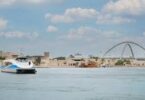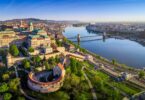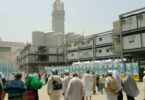Monitoring Desk
Going to Tyumen, one can hear: “Are you going to exile?” and “What’s there to see besides oil?” It turned out, even as it is – so much so that a week is hardly enough. About where to swim in a thermal spring with seawater, try fish soup with “oil”, spend the night in prison and become an officer of Peter’s times – in the material of the RIA Novosti correspondent, who flew to Tyumen from Moscow on the first tourist charter.
Baths and platbands
More than 400 million years ago, a huge warm sea splashed here. It went away, but when they started looking for oil in the region, they came across inexhaustible reserves of salty mineral water at a depth of more than a kilometer. It upset the oil workers then, but it undoubtedly pleases tourists now, especially in winter.
Imagine: it’s cold outside, dank, and you are lying in the bubbling mineral water with a temperature of 38-40 degrees in the open air – beauty.
There are several dozen thermal spas and sanatoriums in Tyumen, and there are not such crowds in them as in the promoted baths of Hungary or the Czech Republic. Somewhere it is just a compact pool in the courtyard of the hotel, and somewhere it is a large one with hydromassage. There are also water parks and spas.
But, of course, this region is famous not only for thermal springs. Several centuries before the discovery of oil fields, the Siberian highway passed through Tyumen and Tobolsk – part of the Great Silk Road connecting Russia with China.
You can start your acquaintance with the city from the only four-level embankment in Russia and the Lovers’ Bridge. In general, the embankment appeared to prevent the erosion of the coast, but soon became a favorite place for walking.
The ancient wooden houses of artisans and merchants have miraculously survived in the center of Tyumen. Many, such as the former Chiralov mansion, are decorated with intricate carvings in the Baroque style (they can cost almost more than the rest of the house).
Now there are museums and restaurants, due to which the architectural monuments are kept in good condition.
Ear with “oil” and a three-meter pancake
You can visit the drilling site where oil workers are being trained. Everything is serious here. It is necessary to undergo a safety briefing and put on a helmet – only then are they allowed to climb inside a real drilling rig and take a picture at the control panel.
A few lucky ones, to their indescribable delight, are allowed to start the oil pump. The excursion ends with a field lunch. Tourists are treated to a specialty – fish soup with “oil”. It is not clear whether it was real, but the taste of the ear is amazing.
In an hour with a short drive from the city – Yalutorovsk, where they cooked a giant three-meter pancake. At the entrance to the prison there is a carnival fair: noisy, fervently, there are round dances.
It is very large-scale: huge pancakes are baked right on the street, washed down with herbal tea from a two-meter samovar.
Prison and hut
The next day we leave for Tobolsk. First of all, we go to see the Kremlin. It stands on a high hill and walking around you can imagine how caravans from India, Iran and Afghanistan came here. Most of the buildings in the lower city can be seen from above.
Be sure to check out the local restaurant serving Chef David’s signature dumplings, stewed beef and crushed potatoes, and honey cake with cranberries.
We had lunch and went straight to the prison of tsarist times. One wing has been converted into a hostel, so if you wish, you can spend the night here – in complete comfort. Although on request, they provide a robe and shackles.
We still spend the night in the tourist complex “Abalak” on the banks of the Irtysh. In fact, this is a reconstruction of a fort – a wooden village-fortress, surrounded by a wall of sharpened logs. Cossacks set them up when they explored Siberia.
It was not without performance: Baba Yaga meets tourists and brings them to house numbers.
“Hut-hut!” She commands. The house starts to rotate. A view of the sunset, the Serpent Gorynych, the bears, the Little Humpbacked Horse floats by. As it should be in a real Russian fairy tale – the further, the more terrifying ”, – says the tourist Ivan Afanasyev.
The rooms are stylized as a peasant hut: a warm stove, a wooden tub-tub.
Like in the movies
In the morning we go to the filming location of the historical drama “Tobol” based on the novel of the same name by Alexey Ivanov. Drum roll, soldiers in the uniform of Peter the Great keep repeating: “Take care of the city, Ilya the prophet!” This is a conditional alarm signal, a quote from a film about a young officer who, by order of the tsar, went to Siberia.
Here, on the site of a tank farm, a whole village was built in just three months. Not a layout with cardboard facades, but houses made of logs, canals, wooden roads. Signs with a QR code will help you figure it out: you point your phone and see footage from the film.
“After filming, the park was mothballed for two years. Overgrown with grass so that it was not visible. The props were sent for storage. Some of the boards have managed to rot, so we are not letting them into the depths of the park yet, ”explains Anastasia Romanova, the film’s producer. According to her, everything is slowly being restored, preparing for the opening.
You can try on outfits from the beginning of the 18th century and arrange a costume photo session with props from the film.
The Romanovs and Rasputin
In Tobolsk, you should definitely go to the Governor’s House. There is a museum of the family of Emperor Nicholas II, who spent a year here in exile. “Usually such places make me sad … But this time it was different thanks to the wonderful guide Denis Ivanov. He was able to recreate the atmosphere of the time, told what the Romanovs were, – the tourist Maria Denisova shared her impressions. “It seemed that I had lived in this house for the last few months with the Russian tsar and his family.”
About a hundred kilometers from Tobolsk is the village of Pokrovskoye, the birthplace of Grigory Rasputin. The private museum was founded by the Smirnov family, who have devoted more than 30 years to the study of this mysterious historical figure.
Perhaps the most famous exhibit is the Viennese chair that belonged to Rasputin. Not easy: it is believed that if you sit down, luck and career growth are guaranteed.
And desires are also fulfilled by the portrait of Rasputin, painted by a contemporary artist from Tyumen Igor Ryazantsev. He created his own, patented painting style – philumism.
Works with the finest threads of acrylic paint with the addition of gold, applying them to the canvas with a disposable medical syringe with a broken needle.
Down with myths
Souvenirs can be bought at the airport: oddly enough, much is cheaper there than in the city. Tourists bring with them local sweets, cone jam, venison and, of course, pine nuts.
If you want something original, there is a kalyuka – an unusual ancient Russian flute without holes. They also sell all kinds of jew’s harps, crafts made of mammoth bones, leather, wood and, of course, flasks with oil.
Tourist charters in Tyumen will last until October 2. “There is an excellent infrastructure for traveling, there is an opportunity to do interesting programs. However, the region is not yet perceived as a tourist destination, ”says TUI Russia CEO Taras Demura. According to him, stereotypes interfere with this.
Courtesy: (ria.ru)






